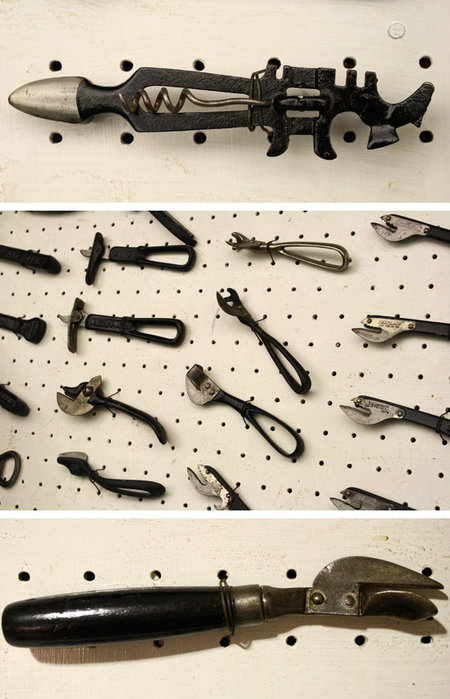Can Openers Exposed!
Continued from Home
These early cans were made of thick, heavy iron and actually included the instructions to “cut round the top near the outer edge with a chisel and hammer.” (Soldiers on the battlefield, lacking those implements, found that bayonets, rocks, and even guns did the job.) It wasn’t until 1855 that a British maker of surgical instruments and knives, Robert Yates, patented the first can opener, which used a lever knife with a sharp blade. As cans were made with lighter-weight metal, variations evolved including an 1858 lever-type opener that employed a sharp sickle that was pushed into a can and then sawed around the edge, the key opener seen on sardine cans in 1866, and the rotating-wheel can opener in 1870. The latter resembles can openers in use today, except that cans first had to be pierced in the center with a sharp metal rod and opening them required significant strength. In 1925, the Star Can Opener Company of San Francisco added the second, toothed wheel, which firmly gripped the edge of the can.
Although the first electric can openers appeared in 1931, it wasn’t until the mid-1950s that freestanding electric openers in avocado green, pink, and aqua were met with popular appeal. And in the 1980s, a can opener that cut cans open on their sides, rather than the top, appeared. Can openers from the collection of the late James Montag, courtesy of his daughter Doris Montag.
Can openers from the collection of the late James Montag, courtesy of his daughter Doris Montag.
Though can openers are typically something of an afterthought, there is one type that has achieved nearly legendary status — the military-issued P-38 and P-51 openers (so named for their size — the P-38 is 38mm in length). Small, light, and easy to tuck into a pocket or attach to a key ring (and vastly superior to bayonets and rocks), the openers were distributed to GIs from World War II through the 1980s, enabling them to open their meals — K-rations and later, C-rations. The simple tool also could double as a screwdriver. Though the U.S. Armed Forces now eat MREs (Meals Ready to Eat) that don’t require openers, relief organizations still distribute P-38s along with canned food during disaster and rescue operations.
Changes in product packaging mean that cranking on a can opener is no longer a daily ritual. Pull-tab cans invented in 1963 for beer and 1964 for carbonated drinks eliminated the need for simple “church-key” openers, and today foods of all types are packed in versions of these (more expensive) containers.
Even so, most of us still have a can opener nestled in our kitchen drawers, and I certainly understand why can openers have been reinvented over the years. Food is a requirement for life and a simple, efficient can opener is sometimes all that stands between a tin can and hunger. My father, a retired U.S. Marine, says that years after he needed it, carrying a P-38 made him feel secure. Without an opener, a can’s contents remain inaccessible to battle-weary soldiers and mothers of small children — with a good one it’s possible to provide sustenance, sate a yappy pup, and quell the rumble of empty stomachs.
Linzee Kull McCray, a.k.a. lkmccray, is a writer and editor living in Iowa. Visit her blog.